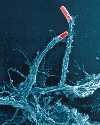
There are many types of Shigella bacteria found throughout science. Shigella are nonmotive, nonsporeforming rod-shaped Gram-negative bacteria. Shigella is predominately found in humans and other primates such as monkeys and chimpanzees. This organism is most commonly found in water that has been polluted with human feces. Shigella dysenteriae is known for its unusually enteric pathogen that causes endemic or epidemic dysentery with hate death rates.

There have been several large-scale outbreaks and is likely that most developing countries are at risk of this epidemic. More than 500,000 cases and 20,000 deaths occurred from an epidemic in Central America from 1969 to 1973. Also in central and southern Africa an epidemic affected at least nine countries. There are approximately 300,000 cases of Shigella that occur annually in the United States. One surprising outbreak was in 1988 numerous individuals contracted shigellosis from food that was served aboard Northwest Airlines flights. The foods on these flights had been prepared in one
This disease is caused when the Shigella organisms attach themselves to, and penetrates epithelial cells of the intestinal mucosa. They then begin to multiply with the cells and spread to more epithelial cells resulting in tissue destruction. Some of the strains may produce harmful substances like enterotoxin and Shiga toxin.
During dysentery, Shigella are excreted in large numbers in the stool (106-108 bacterica per gram). Shigella is known to survive in soiled linen for up to seven weeks, in fresh water from five to eleven days, in salt water for 12-30 hours, in dust at room temperature for six weeks, in sour
milk for four weeks, and in kitchen refuse for aprroximately 1-4 days.
Shigellosis can usually be treated with antibiotics. The antibiotics commonly used for treatment are ampicillin, trimethoprim/sulfamethoxazole, nalidixic acid, or ciprofloxacin. Appropriate treatment kills the Shigella bacteria that might be present in the patient's stools, and shortens the illness. Unfortunately, some Shigella bacteria have become resistant to antibiotics and using antibiotics to treat shigellosis can actually make the germs more resistant in the future. Persons with mild infections will usually recover quickly without antibiotic treatment.
Infection of this disease is most common in poor sanitation areas and unsafe water supplies. However, its illness tends to be seasonal, occurring during hot, wet weather. Transmission of Shigella probably occurs from person-to-person contact and through contaminated food and water.
Symptoms of Shigella include abdominal pain, cramps, diarrhea, fever, vomiting, either blood, pus, or mucus in stools, and tenesmus. Its onset is only about 12 to 50 hours.
Reference:
Microsoft Encarta '99
http://vm.cfsan.fda.gov/~mow/chap19.html
http://www.who.int/chd/publications/cholera/shig4g.htm
Return
to Bacterial Disease Page